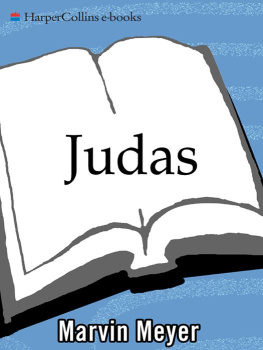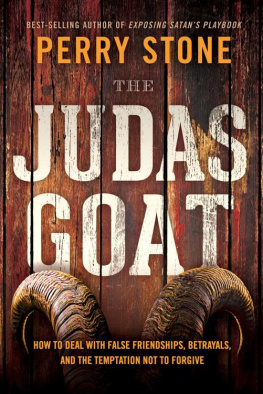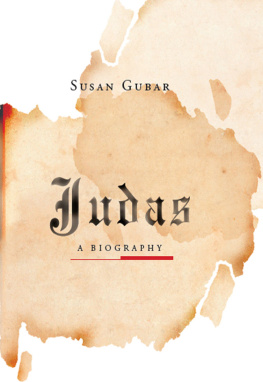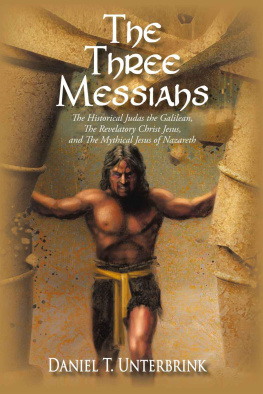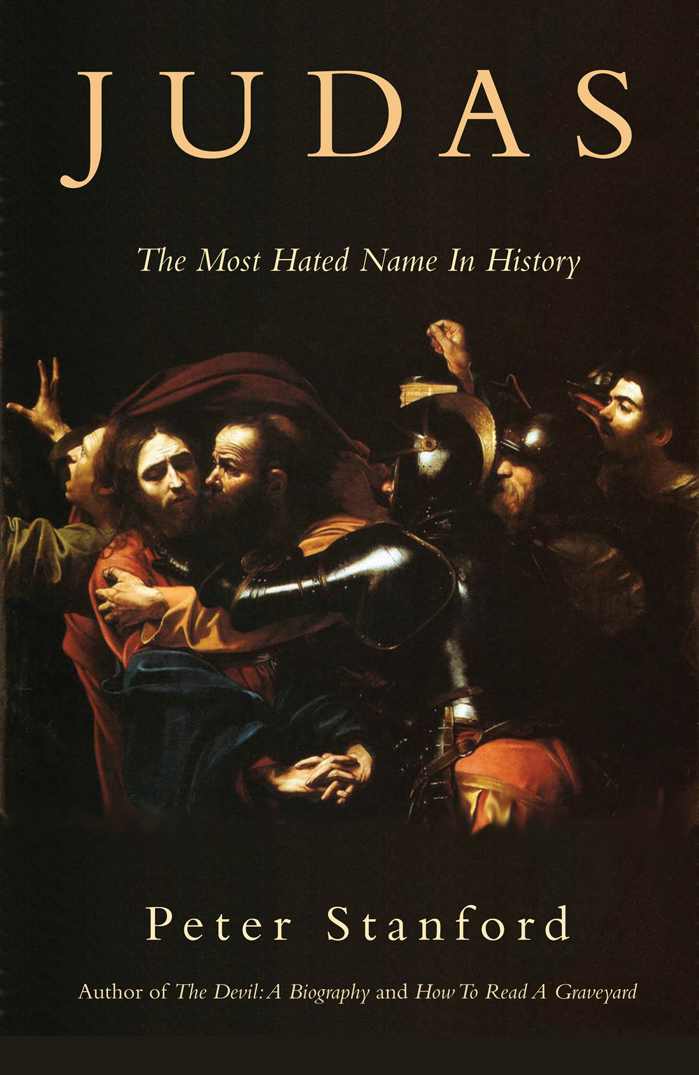
JUDAS

Copyright 2015 by Peter Stanford
All rights reserved under International and Pan-American Copyright Conventions. No part of this book may be used or reproduced in any manner whatsoever without written permission from the publisher, except in the case of brief quotations embodied in critical articles and reviews.
Originally published by Hodder & Stoughton Limited, a Hachette UK Limited company
Library of Congress Cataloging-in-Publication Data
Stanford, Peter, 1961
Judas: the most hated name in history / Peter Stanford.
pages cm
Includes bibliographical references and index.
1. Judas Iscariot. I. Title.
BS2460.J8S73 2016
226.092dc23
2015036010
COUNTERPOINT
2560 Ninth Street, Suite 318
Berkeley, CA 94710
www.counterpointpress.com
Distributed by Publishers Group West
10 9 8 7 6 5 4 3 2 1
e-book ISBN 978-1-61902-750-3
ALSO BY PETER STANFORD
How To Read a Graveyard:
Journeys in the Company of the Dead
The Death of a Child (editor)
The Extra Mile: A 21st Century Pilgrimage
C Day-Lewis: A Life
Why I Am Still A Catholic:
Essays in Faith and Perseverance (editor)
Heaven: A Travellers Guide to the Undiscovered Country
Bronwen Astor: Her Life and Times
The She-Pope: A Quest for the Truth Behind
The Mystery of Pope Joan
The Devil: A Biography
The Outcasts Outcast: A Life of Lord Longford
Cardinal Hume and the Changing Face of English Catholicism
Catholics and Sex (with Kate Saunders)
Believing Bishops (with Simon Lee)
For Sue and Steve:
for your encouragement and enthusiasm
Table of Contents
Guide
Contents
Twas the body of Judas Iscariot
Lay in the Field of Blood;
Twas the soul of Judas Iscariot
Beside the body stood.
Robert Buchanan: The Ballad of
Judas Iscariot (1874)
The signage in Jerusalem is, at best, intermittent. On the journey in from the airport at Tel Aviv, there are familiar, standard-issue, large roadside boards, with directions in three languages Arabic, Hebrew and English. Once inside the Old City, with its Jewish, Muslim, Christian and Armenian quarters, it all gets much more hit and miss: odd arrows here and there, often with any wording obscured by a market vendors display of holy pictures, pottery or pyjamas, pointing variously to the Western Wall, holy of holies for Jews, or the Church of the Holy Sepulchre, standing on what is believed to be the site where Jesus was crucified, or the Al-Aqsa mosque, high on the list of must-see sites for Muslims. But never all three at once. Perhaps to apply the most benign standards it is assumed that in such a small space (within its ancient walls, the Old City of Jerusalem amounts to just under a square kilometre), visitors will inevitably stumble on this extraordinary trinity if they walk around for long enough.
In my wanderings, I only spy one sign for Hakeldama (originally the Aramaic hagel dema, sometimes rendered as the Greek Akeldama, and meaning Field of Blood), the spot where Christian tradition holds that one of the twelve apostles, Judas Iscariot, ignominiously committed suicide after betraying Jesus. And, even then, it is very much a forgotten footnote, down in the corner of a weather-beaten outdoor pilgrims map on display at the church of Saint Peter in Gallicantu, outside the Old City. Everywhere else is name-checked in big letters, with a rough drawing next to it. Hakeldama, though, floats on the margins of the map, as if halfway to oblivion.
If visitors did once seek out the scene of Judas last moments on earth, and there is plenty of historical evidence that pilgrims did, then it has now fallen from the itineraries of the estimated 3.5 million tourists who come to Jerusalem each year. Such modern neglect has a certain logic. Encouraging hordes to seek out the spot where Christianitys most notorious traitor hanged himself would, in secular times, add a curious voyeuristic twist to 2,000 years of vilifying Judas, whom the gospels describe as partaking in the first-ever Eucharist at the Last Supper, but still managing afterwards to sell his master for a measly thirty pieces of silver.
That tawdry transaction was the first never-to-be-forgotten moment of infamy in the tale of Judas that has been handed down the centuries. In the core texts of Christianity, the second instalment comes soon afterwards when, in the Garden of Gethsemane, Judas identifies Jesus to a detachment of soldiers with the notorious Judas kiss. That embrace, outwardly of friendship but in reality of betrayal, has come to sum up the reputation of the traitor within Jesus trusted inner circle. And then, with Christianity for centuries confining Judas biography to a three-act drama, there is the concluding spectacle of the false apostle yielding to despair and killing himself.
What is there, then, to see at the Field of Blood, other than the ugliest side of human nature and frankly there is enough of that to witness day to day in the grating tension between holiness and darkness in the divided city of Jerusalem? Judas place of death, moreover, offers no enticing prospect of the sort of spiritual nourishment that today draws even the most sceptical visitors to Jerusalems array of holy places. All of these sites may still cause endless, bitter disputes between the faiths. The golden-topped Dome of the Rock shrine, for example, alongside its near neighbour, the Al-Aqsa mosque, sits atop the Temple Mount, simultaneously hallowed ground in Judaism, and once commandeered by the invading Crusaders in the twelfth century for their own Christian church. Yet it still attracts crowds. We wait in long lines to pass through security points designed to filter out those fanatics with their guns and bombs who might be tempted to press by force their particular branch of religions claim. Once inside, though, whatever its bloody, factional past and present, this sacred ground still has the capacity to inspire.
By contrast, at Hakeldama, Judas last footprint on earth represents more of a cautionary tale, of the type once found in now-neglected childrens literature such as Struwwelpeter,
And Judas Iscariots name continues in the twenty-first century to represent a crushing rebuke, a despicable traitor, as in the controversialist Lady Gagas 2011 single, Judas, about being in love with a bad un. Jesus is my virtue, she sings in a promotional video bursting with religious imagery, and Judas is the demon I cling to.
Yet, even for that contemporary minority with an overactive interest in the macabre and there are plenty, I have observed, who like nothing better than ghoulishly to travel the globe seeking out haunted places where horrific deeds took place the Field of Blood scores poorly as a desirable destination. There are doubts, above all, about its authenticity.
Whose blood is it that is being remembered? That of Jesus, sacrificed on the cross on Calvary on Good Friday to save humankind, or of Judas, spilled in death following his betrayal of his master? In his gospel, Saint Matthew makes plain that it is Jesus blood. He writes bleakly and movingly (for this listener at least, when hearing the passage read aloud during mass over the years) of Judas wretched remorse once he had sold Jesus out. He tries to salve his conscience by returning his fee the money paid to him for Jesus blood but the chief priests refuse it as tainted. So, the outcast to trump all outcasts flings down the coins in the sanctuary of the Temple, takes himself off to an unnamed site and there commits suicide. The Jewish leaders thereafter pick up the sullied loot that is blood money for Jesus, and use it to purchase a plot, as a graveyard for foreigners, called the Field of Blood.
Next page

